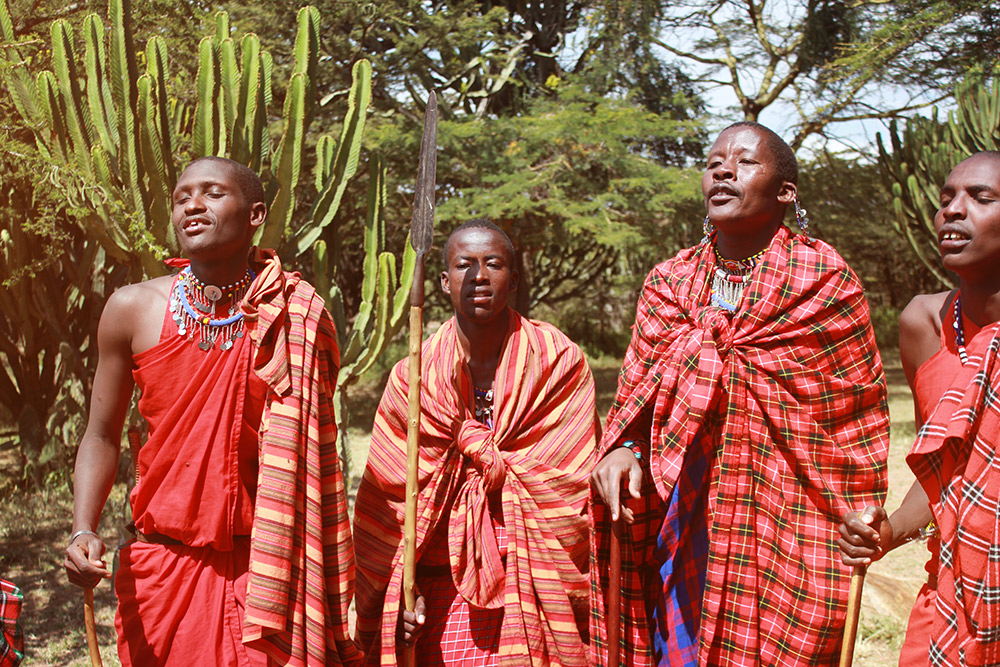Even if you’ve never heard of shuka cloth, there’s a high chance you’ve seen it in pictures. Often red with black stripes, shuka cloth is affectionately known as the “African blanket” and is worn by the Maasai people of East Africa. To give you some brief background knowledge, the Maasai are a semi-nomadic people from East Africa who are known for their unique way of life, as well as their cultural traditions and customs.
Living across the arid lands along the Great Rift Valley in Tanzania and Kenya, the Maasai population is currently at around 1.5 million, with the majority of them living on the Masai Mara National Reserve of Kenya. They are known to be formidable, strong warriors who hunt for food in the wild savannah and live closely with wild animals.
The Maasai identity is often defined by colourful beaded necklaces, an iron rod (as a weapon) and of course, red shuka cloth. While red is the most common colour, the Maasai also use blue, striped, and checkered cloth to wrap around their bodies. It’s known to be durable, strong, and thick — protecting the Maasai from the harsh weather and terrain of the African savannah.

Shuka’s origins
So how did this traditional clothing come about?
The word 'traditional' must be taken with a grain of salt. Before the colonialization of Africa, the Maasai wore leather garments. They only began to replace calf hides and sheep skin with commercial cotton cloth in the 1960s.
But how and why they chose shuka cloth is still unclear today. There are a few schools of thought. One of them is traced back through centuries — fabrics were used as a means of payment during the slave trade and landed in East Africa, while black, blue, and red natural dyes were obtained from Madagascar. There were actually records of red-and-blue checked “guinea cloth” becoming very popular in West Africa during the 18th century. Discover the best time to visit Kenya!

Another interesting explanation is that the Maasai cloth was brought in by Scottish missionaries during the colonial era. The Africa Inland Mission was established in 1895, and until 1909 Kenya was its only operation. This sounds like a logical explanation — after all, shuka cloth does resemble the Scottish plaid or tartan patterns.
These days, however, shuka cloth is usually manufactured in Dar es Salaam and even in China, bearing text such as “The Original Maasai Shuka” on the plastic packaging. Ironically, the Maasai really do buy and wear shukas made in China, packaged in plastic.

Revolution of the Maasai blanket
Recent years have seen shuka cloth popping up in the fashion world and gaining fame all over the globe.
A Kenyan clothing label has taken inspiration from the patterns of the shuka cloth to produce clothes and accessories in vibrant tribal prints. Nairobi-based Wan Fam Clothing was founded by brothers Jeff and Emmanuel Wanjala to pay homage to Kenya's Maasai culture.
By turning a traditional garment into fashionable urban wear, they hope to meet the increased demand for more local products that highlight their heritage. Even Louis Vuitton featured red and blue Maasai checks in their Spring/Summer collection 2012. Learn about the the Maasai jumping dance!
Shuka cloth’s past may still be a mystery, but it looks set to conquer the future.

Getting There
G Adventures runs a number of departures in Kenya encompassing a wide range of departure dates and activities to cater to different tastes. We’re thrilled at the prospect of showing you this big blue planet of ours.























